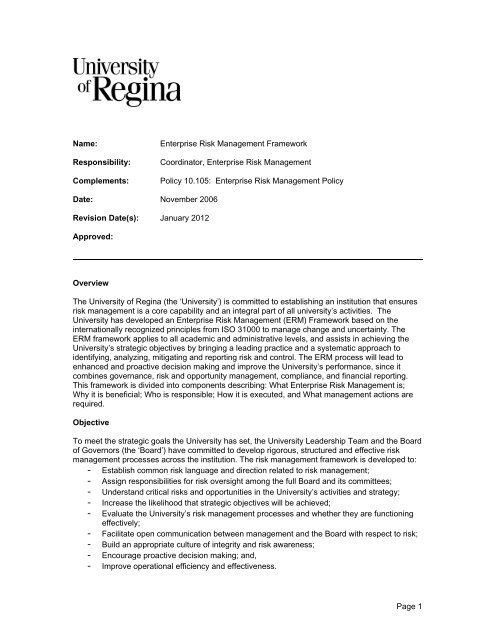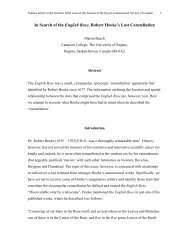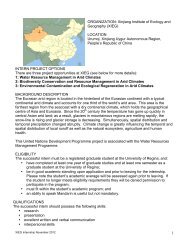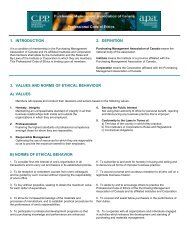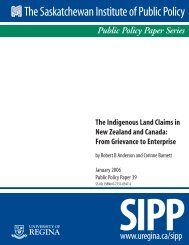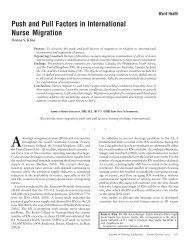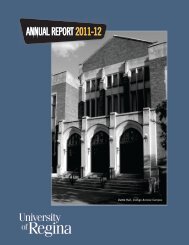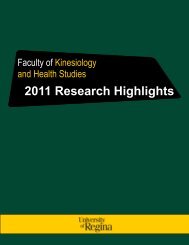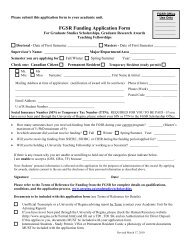Name: Enterprise Risk Management Framework - University of Regina
Name: Enterprise Risk Management Framework - University of Regina
Name: Enterprise Risk Management Framework - University of Regina
Create successful ePaper yourself
Turn your PDF publications into a flip-book with our unique Google optimized e-Paper software.
<strong>Name</strong>:Responsibility:Complements:<strong>Enterprise</strong> <strong>Risk</strong> <strong>Management</strong> <strong>Framework</strong>Coordinator, <strong>Enterprise</strong> <strong>Risk</strong> <strong>Management</strong>Policy 10.105: <strong>Enterprise</strong> <strong>Risk</strong> <strong>Management</strong> PolicyDate: November 2006Revision Date(s): January 2012Approved:OverviewThe <strong>University</strong> <strong>of</strong> <strong>Regina</strong> (the ‘<strong>University</strong>’) is committed to establishing an institution that ensuresrisk management is a core capability and an integral part <strong>of</strong> all university’s activities. The<strong>University</strong> has developed an <strong>Enterprise</strong> <strong>Risk</strong> <strong>Management</strong> (ERM) <strong>Framework</strong> based on theinternationally recognized principles from ISO 31000 to manage change and uncertainty. TheERM framework applies to all academic and administrative levels, and assists in achieving the<strong>University</strong>’s strategic objectives by bringing a leading practice and a systematic approach toidentifying, analyzing, mitigating and reporting risk and control. The ERM process will lead toenhanced and proactive decision making and improve the <strong>University</strong>’s performance, since itcombines governance, risk and opportunity management, compliance, and financial reporting.This framework is divided into components describing: What <strong>Enterprise</strong> <strong>Risk</strong> <strong>Management</strong> is;Why it is beneficial; Who is responsible; How it is executed, and What management actions arerequired.ObjectiveTo meet the strategic goals the <strong>University</strong> has set, the <strong>University</strong> Leadership Team and the Board<strong>of</strong> Governors (the ‘Board’) have committed to develop rigorous, structured and effective riskmanagement processes across the institution. The risk management framework is developed to:- Establish common risk language and direction related to risk management;- Assign responsibilities for risk oversight among the full Board and its committees;- Understand critical risks and opportunities in the <strong>University</strong>’s activities and strategy;- Increase the likelihood that strategic objectives will be achieved;- Evaluate the <strong>University</strong>’s risk management processes and whether they are functioningeffectively;- Facilitate open communication between management and the Board with respect to risk;- Build an appropriate culture <strong>of</strong> integrity and risk awareness;- Encourage proactive decision making; and,- Improve operational efficiency and effectiveness.Page 1
Key ERM DefinitionsThe <strong>University</strong> has adopted internationally accepted definitions from ISO 31000, theinternationally accepted risk management standard 1 .<strong>Risk</strong> – effect <strong>of</strong> uncertainty on business objectives. Simply risk is an event that would deter the<strong>University</strong> from achieving its objectives. <strong>Risk</strong> is <strong>of</strong>ten described in terms <strong>of</strong> a combination <strong>of</strong> theimpact and the associated probability.<strong>Risk</strong> <strong>Management</strong> – the identification, assessment and response to risk to a specific objective orwithin a specific risk category.<strong>Risk</strong> <strong>Management</strong> <strong>Framework</strong> – provides a direction and guidance to strengthen riskmanagement practices within the <strong>University</strong>.<strong>Risk</strong> Owner – person or entity with the responsibility and authority to manage a risk.<strong>Risk</strong> Tolerance – or sometimes known as risk appetite is described as the level <strong>of</strong> risk the<strong>University</strong> is willing to accept in relation to a threat that may cause loss or an opportunity in theday-to-day business activities. The risk tolerance <strong>of</strong> an organization may be different for differentevents. The <strong>University</strong>’s risk tolerance and the alignment between its risk appetite and itsobjectives form part <strong>of</strong> the overall <strong>University</strong> strategy.Control – measure or management action to mitigate risk. It includes the policies, procedures,reporting and initiatives performed by the <strong>University</strong> to ensure that the desired risk response iscarried out. These activities take place at all levels and functions <strong>of</strong> the <strong>University</strong>.Likelihood – the probability <strong>of</strong> an event occurring. Likelihood <strong>of</strong> an event occurring is rated as low,medium, or high.Impact – the severity <strong>of</strong> an event. Impact or severity <strong>of</strong> an event is rated as minor, moderate orsignificant.<strong>Risk</strong> Communication – the process <strong>of</strong> identifying risk and communicating broadly to enable allpersonnel to deliver on their responsibilities.<strong>Risk</strong> Register – <strong>of</strong>ficial recording <strong>of</strong> the identified risks facing the <strong>University</strong>. A catalogue <strong>of</strong> the fullspectrum <strong>of</strong> risks (with impact and likelihood assessed) forms the <strong>University</strong> risk register.Stakeholders - Roles and Responsibilities<strong>Risk</strong> <strong>Management</strong> is the responsibility <strong>of</strong> every employee <strong>of</strong> the <strong>University</strong>. Different stakeholdershave different objectives and levels <strong>of</strong> accountability with respect to risk management. Aneffective risk management framework includes a comprehensive and defined accountability forrisks, controls and risk treatment tasks. The risk management framework documents the rolesand responsibilities <strong>of</strong> the various components <strong>of</strong> a risk management process. The <strong>University</strong>ensures that those who are responsible are equipped to fulfil their role by providing them with theappropriate authority, training and resources.1 International Standard ISO 31000; 2009 <strong>Risk</strong> <strong>Management</strong> Principles and GuidelinesPage 2
Board <strong>of</strong> GovernorsCanadian Securities Administrator (CSA) National Policy 58-201, Corporate GovernanceGuidelines, and National Instrument 58-101 Disclosure <strong>of</strong> Corporate Governance requires thatthe Board 2 :Establish a strategic planning process;Ensure the strategic plan considers potential corporate risks and opportunities;Identify corporate risks and their mitigation strategy; and,Ensure the corporations internal controls are working effectively.The <strong>University</strong>’s Board <strong>of</strong> Governors, through its Audit and <strong>Risk</strong> <strong>Management</strong> Committee, isaccountable for the oversight <strong>of</strong> risk management and the results <strong>of</strong> the <strong>University</strong>. The Board isresponsible to ensure the risk management framework and corresponding results work towardsachieving the strategic objectives <strong>of</strong> teaching, research and public service as identified in the<strong>University</strong>’s strategic plan ‘mâmawohkamâtowin: Our Work, Our People, OurCommunities’.Audit and <strong>Risk</strong> <strong>Management</strong> CommitteeThe Audit and <strong>Risk</strong> <strong>Management</strong> Committee <strong>of</strong> the Board is responsible for:- Determining the <strong>University</strong>’s approach to risk;- Approving the risk management policy/framework;- Identifying the risks inherent in the <strong>University</strong>’s strategy;- Monitoring and evaluating the effectiveness <strong>of</strong> risk management activities; and,- Ensuring the <strong>University</strong> has effective crisis management systems and contingency plans.<strong>University</strong> Leadership TeamThe <strong>University</strong> Leadership Team is responsible for:- Providing top down support;- Identifying emerging strategic and operational risks and assessing them based onlikelihood and impact;- Setting a risk tolerance level;- Reporting on key risks and the effectiveness <strong>of</strong> the corresponding mitigation strategies;- Ownership and day-to-day oversight and management <strong>of</strong> individual risks; and,- Ensuring alignment between the <strong>University</strong>’s strategic objectives and risk management.<strong>Enterprise</strong> <strong>Risk</strong> <strong>Management</strong> Steering CommitteeThe <strong>Enterprise</strong> <strong>Risk</strong> <strong>Management</strong> Steering Committee is responsible for:- Reviewing and providing advice on the risk management framework, ensuringappropriate consultation, and recommending it to the Audit and <strong>Risk</strong> <strong>Management</strong>Committee;2 Ontario Securities Commission ‐ National Policy 58‐201. Corporate Governance Guidelineshttp://www.osc.gov.on.ca/documents/en/Securities‐Category5/rule_20050415_58‐201_govpractices_2.pdfPage 3
- Evaluating and/or supporting academic and administrative units in the identification andreporting <strong>of</strong> material risks;- Ensuring that business units are assessing their risks based on likelihood and impact tothe <strong>University</strong>;- Determining whether material risks being accepted across the <strong>University</strong> are consistentwith the <strong>University</strong>’s risk tolerance level;- Reviewing and assessing processes, controls and mitigation strategies; and,- Overseeing the development <strong>of</strong> the risk register and reporting to the <strong>University</strong>Leadership Team and the Audit and <strong>Risk</strong> Committee.<strong>Enterprise</strong> <strong>Risk</strong> <strong>Management</strong> CoordinatorThe <strong>Enterprise</strong> <strong>Risk</strong> <strong>Management</strong> Coordinator is responsible for:- Assisting the Audit and <strong>Risk</strong> <strong>Management</strong> Committee in the oversight <strong>of</strong> riskmanagement by leading the development and implementation <strong>of</strong> the ERM framework;- Providing risk assessment training and workshops to <strong>University</strong> <strong>of</strong>ficials as required;- Conducting risk assessments, both internal to the <strong>University</strong> and within the Canadianpost-secondary education system, to identify material risks to the <strong>University</strong>;- Bringing a systematic approach to evaluating and improving the effectiveness <strong>of</strong> riskmanagement and control;- Ensuring accurate and reliable risk documents exist, and relevant information is providedto the Audit and <strong>Risk</strong> <strong>Management</strong> Committee; and,- Participating in the drafting and review <strong>of</strong> the <strong>University</strong>’s annual report related to riskmanagement and oversight.ERM MethodologyThe <strong>University</strong>’s methodology for risk management is shown in Figure 1 3 and is simply a flowchart expression <strong>of</strong> the risk management activities. The process is continuous and can beapplied at both the <strong>University</strong> (enterprise) level or at an individual academic and administrativeunit level.3 International Standard ISO 31000; 2009 <strong>Risk</strong> <strong>Management</strong> Principles and GuidelinesPage 4
Figure 1<strong>Risk</strong> <strong>Management</strong> ProcessStrategic/Operational ObjectivesCommunication & ConsultationEstablish the Context<strong>Risk</strong> AssessmentIdentify <strong>Risk</strong>sAnalyze <strong>Risk</strong>sEvaluate <strong>Risk</strong>sMonitor & Review<strong>Risk</strong> TreatmentThe eight interrelated components form the basis for establishing and putting ERM into practiceat the <strong>University</strong>. Each component is described in more detail as follows:a. Objective Setting is the process <strong>of</strong> determining the strategic objectives for the <strong>University</strong>and its risk strategy. The strategic planning process also requires all divisions andbusiness units define their key business/operational objectives and targets.b. Establishing the context consists <strong>of</strong> the internal and external environment <strong>of</strong> the<strong>University</strong>. They form the foundation for defining the <strong>University</strong>’s risk approach and riskappetite. Internal Environment comprises the <strong>University</strong>’s history, culture, values,organizational structure, strategy, policies or procedures. External Environmentcomprises the social, cultural, political, legal, regulatory, financial, economical ortechnological environment in which the university operates.c. <strong>Risk</strong>, Event and Trend Identification describes those developments either internal orexternal to the <strong>University</strong> that could significantly affect its ability to meet its strategicobjectives, either positively or negatively. In order to assure that the full scope <strong>of</strong> thePage 5
<strong>University</strong> is considered, event and trend identification is done broadly engaging a crosssection<strong>of</strong> <strong>University</strong> members.There are two approaches utilized for identifying key risks at the <strong>University</strong>:1. Top-down approach: starts by identifying enterprise-wide risks that affect the<strong>University</strong>’s strategic objectives. This approach involves the <strong>University</strong>’sLeadership Team and the Board.2. Bottom-up approach: starts by identifying business unit level or operationalrisks. This approach usually involves middle management.d. <strong>Risk</strong> Analysis describes the extent to which potential events and trends might affect the<strong>University</strong>’s objectives. Events and trends are assessed by two criteria – impact andlikelihood. Figure 2 displays a matrix known as a <strong>Risk</strong> Heat Map that graphicallyrepresents the impact and likelihood <strong>of</strong> each risk, as well as the correspondingmanagement action. The color gradient from green (low) to red (high) provides acomparative level <strong>of</strong> priority when evaluating the <strong>University</strong>’s risks. This matrix is used toevaluate risk at both the inherent (without management or control) and residual (withmanagement or control) levels. The corresponding management action suggests theappropriate response or treatment for risks assessed in that area <strong>of</strong> the matrix. <strong>Risk</strong>analysis can be done by qualitative and/or quantitative methods.Figure 2<strong>Risk</strong> Heat Map and Corresponding TreatmentSignificantIMPACTFinancial Loss >$ 5MMStakeholder faith impacted and lasts >18 monthsIsolated or Multiple Loss <strong>of</strong> LifeSignificant or multiple events <strong>of</strong> fine, fraud orlegal actionComplete system crash with loss <strong>of</strong> critical dataInability to recruit, retain staff to operateLabour disruption that impacts graduationConsiderablemanagementrequired<strong>Risk</strong> <strong>Management</strong> ActionsMust manageandmonitor risksExtensivemanagementessentialModerateFinancial Loss < $5 MMStakeholder faith impacted and lasts6-12 monthsSignificant injury to one or moreIsolate incidents <strong>of</strong> a fine, fraud or legal actionSystem crash during a peak periodDifficulties in recruit and retain staffLabour disruption that impacts operations <strong>of</strong> anyduration<strong>Risk</strong>s may beworthaccepting withmonitoring<strong>Management</strong>effortworthwhile<strong>Management</strong>effortrequiredMinor Financial Loss
i. Avoid (eliminate) the risk;ii. Reduce (mitigate) the risk;iii. Transfer the risk (e.g. insurance);iv. Share the risk; or,v. Accept the risk.c. A formal or informal evaluation <strong>of</strong> risk will be considered depending on the scope <strong>of</strong> thedecision or action taken at the <strong>University</strong>. This will be done both at the onset and throughoutthe life <strong>of</strong> the decision or action. Where applicable and quantifiable, the expected cost <strong>of</strong> therisk will be considered in the business case used in the decision and evaluation process.d. There will be a desire to learn from events that have transpired - the risk managementprocess is a cycle where experience provides key information for new decisions and actions.Open and appropriate communication <strong>of</strong> results and lessons learned is required to facilitatelearning.e. The <strong>University</strong> risk register will be evaluated regularly. New risks will be considered, andrisks no longer relevant will be removed. The risk register will be refreshed by rating thelikelihood and impact for each risk. This information is used to prioritize the risks and this, inturn, flows into the <strong>University</strong> planning cycle.References1. International Standard ISO 31000; 2009 <strong>Risk</strong> <strong>Management</strong> Principles and Guidelines2. Treasury Board <strong>of</strong> Canada. Integrated <strong>Risk</strong> <strong>Management</strong> <strong>Framework</strong>.http://www.tbs-sct.gc.ca/pubs_pol/dcgpubs/riskmanagement/rmf-cgr01-1_e.asp3. <strong>Risk</strong> Oversight Inc. www.riskoversight.caPage 8


